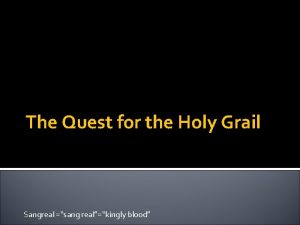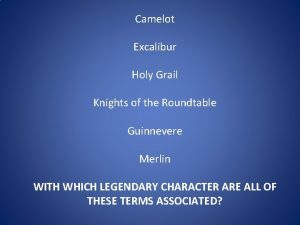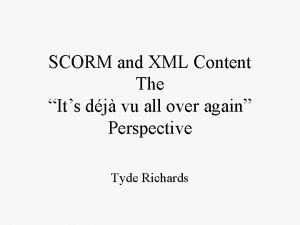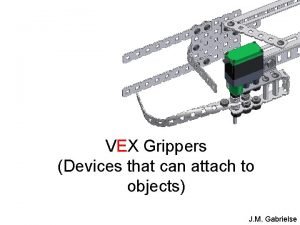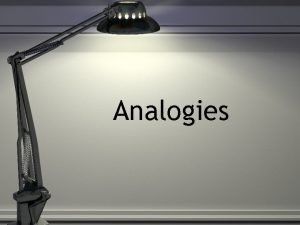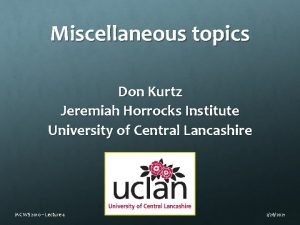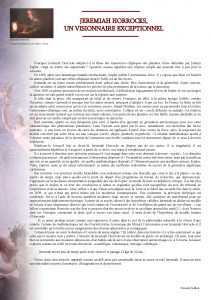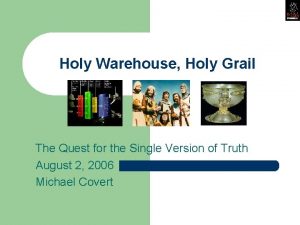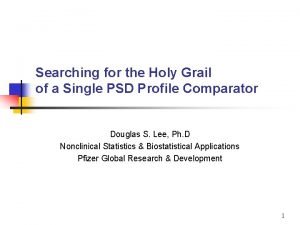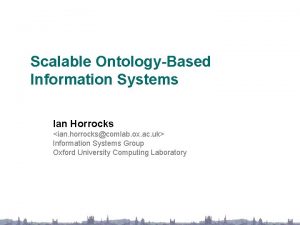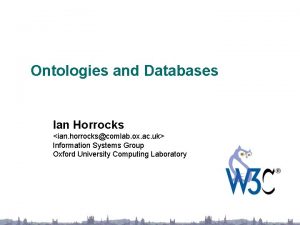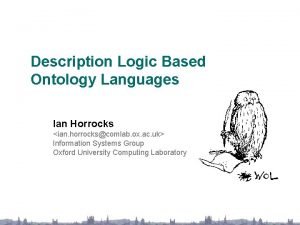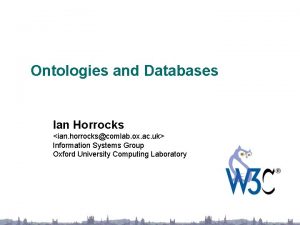Searching for the Holy Grail Ian Horrocks ian


























































- Slides: 58


Searching for the Holy Grail Ian Horrocks <ian. horrocks@comlab. ox. ac. uk> Information Systems Group Oxford University Computing Laboratory

Background and Motivation • Medicine has a large and complex vocabulary • Long history of “formalising” and codifying medical vocabulary – Numerous medical “controlled vocabularies” of various types • Large size of static coding schemes makes them difficult to build and maintain – Many terminologies specific to purpose (statistical analysis, bibliographic retrieval), specialty (epidemiology, pathology) or even database – Ad hoc terms frequently added to cover fine detail required for clinical care

Background and Motivation Schemes such as SNOMED tackled some of these problems by allowing codes to be constructed, but this introduced its own problems: – Vague semantics, e. g. , conflating different relations: T-1 X 500 = bone T-1 X 501 = long bone (kind-of) T-1 X 505 = shaft of bone (part-of) T-1 X 520 = cortex of bone (constituent-of)

Background and Motivation Schemes such as SNOMED tackled some of these problems by allowing codes to be constructed, but this introduced its own problems: – Redundancy, e. g. : T-28000 + E-2001 + F-03003 + D-0188 = tuberculosis in lung caused by M. tuberculosis together with fever

Background and Motivation Schemes such as SNOMED tackled some of these problems by allowing codes to be constructed, but this introduced its own problems: – Nonsensical terms, e. g. : T-67000 + M-12000 + E-4986 + F-90000 = fracture in colon caused by donkey together with emotional state

Proposed Solution Use a conceptual model • Detailed descriptions with clear semantics and principled extensibility • Can use tools to support development and deployment, e. g. : – Consistency checking and schema enrichment through the computation of implicit subsumption relationships – Intensional and extensional query answering and query optimisation

GALEN Project Goals of the project were: • Design/select an appropriate (for medical terminology) modelling language: GRAIL • Develop tools to support conceptual modelling in this language: GRAIL classifier (amongst others) • Use these tools to develop a suitable model of medical terminology: GALEN terminology (aka ontology)

Recognised Problems • Classifier too slow – Over 24 hours to classify ontology • My mission: make it go faster – Hint: DL research might be relevant

Unrecognised Problems • Vague semantics – no formal specification or mapping to (description) logic • Language lacked many features – cardinality restrictions (other than functional roles) – negation and disjunction (not even disjointness) • Reasoning via ad hoc structural approach – incorrect w. r. t. any reasonable semantics

Why Not Use a DL? • Formalise semantics – establish mapping from GRAIL to a suitable DL • Use suitable DL reasoner to classify resulting TBox – must support transitive roles, GCIs, etc. • Does such a reasoner exist? – Yes: LOOM Idea: translate GALEN ontology into LOOM DL and use LOOM classifier

The False Grail Results less than 100% satisfying: • It gets the wrong answer (fails to find obvious subsumptions) • It’s even slower than the GRAIL classifier Lesson: No such thing as a free lunch!

Back to the Drawing Board Idea: Implement my own fast and correct reasoner for a very expressive DL!

Implementing a DL Reasoner • What algorithm is implemented in LOOM? “. . . utilizes forward-chaining, semantic unification and object-oriented truth maintenance technologies. . . ” • Alternative approaches? tableau algorithms

Implementing a Tableau Reasoner • Advantages: – algorithms relatively simple, precisely described and available for a range of different logics – formal correctness proofs, and even some work on implementation & optimisation (KRIS) • Disadvantages: – only relatively simple DLs have so far been implemented – need transitive and functional roles, role hierarchy and GCIs Idea: extend Baader/Sattler transitive orbits to (transitive and functional) role hierarchy, and internalise GCIs

Implementing a Tableau Reasoner Results less than 100% satisfying: • It fails to get any answer – effectively non-terminating • Discouraged? – not a bit of it! – Sustained by ignorance and naivety, the quest continues Idea: Implement a highly optimised tableau reasoner

Optimising (Tableau) Reasoners Performance problems mainly caused by GCIs – standard “theoretical” technique is to use internalisation: , and applied to every individual using a “universal role” – convenient for proofs (TBox satisfiability can be reduced to concept satisfiability), but hopelessly inefficient in practice • over 1, 200 GCIs in GALEN ontology • resulting search space is impossibly large Lesson: Theory is not the same as practice!

Optimising (Tableau) Reasoners Idea: suggested by structure of GALEN KB – GCIs all of the form – can be rewritten as – and “absorbed” into primitive “definition” axiom for – resulting TBox is “definitorial” • no GCIs • dealt with via lazy unfolding Result: close, but no cigar – search space still too large – effective non-termination

Optimising (Tableau) Reasoners Idea: Investigate other optimisations, e. g. , from SAT – simplifications (e. g. , Boolean Constraint Propagation) – semantic branching – caching – heuristics – smart backtracking Result: (qualified) success! – “Fa. CT” reasoner classified GALEN core in <400 s

Qualifications • Only works for GALEN “core” – full ontology is much larger & couldn’t be classified by Fa. CT • No support for complex roles – GRAIL allows for axioms of form • Weak (cheating? ) semantics for inverse roles – GRAIL treats them as pre-processing macros: Result: progress, but still searching for the Holy Grail!

Extending the Logic • Qualified Cardinality Restrictions – relatively trivial extension to functional roles • Inverse roles – new “double blocking” technique Result: is born! • But. . . – still can’t classify GALEN – relatively few other applications

Testing and Optimisation Few ontologies, so testing focused on synthetic data – hand crafted “hard” tests – randomly generated tests – most hand crafted tests easy for optimised systems, so attention focused on randomly generated tests Result: semantic branching is a crucial optimisation

Semantic Branching Technique derived from SAT testing – guess truth values for predicates occurring in disjunctions; use heuristics to select predicate and valuation; e. g. : given guess which implies and Result: – great for random data, but useless/harmful for ontologies – e. g. , given we get – heuristics assume sat: unsat ≈ 50: 50; far from true in ontologies Lesson: careful study of typical inputs crucial for successful optimisation

Applications? • Medical terminologies • Configuration? • DB schema design and integration?

Semantic Web: Killer App for DLs • According to TBL, the Semantic Web is “. . . a consistent logical web of data. . . ” in which “. . . information is given well-defined meaning …” • Idea was to achieve this by adding semantic annotations – RDF used to provide annotation mechanism – Ontologies used to provide vocabulary for annotations • Evolved goal is to transform web into a platform for distributed applications and sharing (linking) data – RDF provides uniform syntactic structure for data – Ontologies provide machine readable schemas

Web Ontology Languages • RDF extended to RDFS, a primitive ontology language – classes and properties; sub/super-classes (and properties); range and domain (of properties) • But RDFS lacks important features, e. g. : – existence/cardinality constraints; transitive or inverse properties; localised range and domain constraints, … • And RDF(S) has “higher order flavour” with no (later non-standard) formal semantics – meaning not well defined (e. g. , argument over range/domain) – difficult to provide reasoning support

From RDFS to OIL At DFKI in Kaiserslautern at a “Sharing Day on Ontologies” for projects of the ESPRIT LTI programme

From RDFS to OIL At DFKI in Kaiserslautern at a “Sharing Day on Ontologies” for projects of the ESPRIT LTI programme • Started working with Deiter Fensel on development of an “ontology language” – On-To-Knowledge project developing web ontology language – initially rather informal and based on frames – were persuaded to use DL to formalise and provide reasoning

From RDFS to OIL At DFKI in Kaiserslautern at a “Sharing Day on Ontologies” for projects of the ESPRIT LTI programme • Started working with Deiter Fensel on development of an “ontology language” – On-To-Knowledge project developing web ontology language – initially rather informal and based on frames – were persuaded to use DL to formalise and provide reasoning • Soon joined by Frank van Harmelen, and together we developed OIL – basically just DL with frame-like syntax – initially “Manchester” style syntax, but later XML and RDF

From OIL to OWL • DARPA DAML program also developed DAML-ONT • Efforts “merged” to produce DAML+OIL – Further development carried out by “Joint EU/US Committee on Agent Markup Languages”

From OIL to OWL • DARPA DAML program also developed DAML-ONT • Efforts “merged” to produce DAML+OIL – Further development carried out by “Joint EU/US Committee on Agent Markup Languages” • DAML+OIL submitted to as basis for standardisation • Web. Ont Working Group formed – Web. Ont developed OWL language based on DAML+OIL – OWL became a W 3 C recommendation – OWL extended DAML+OIL with nominals: “Web-friendly” syntax for

Was it Worth It?

Was it Worth It? Ontologies before: and of course Galen!

Was it Worth It? Ontologies after:

Was it Worth It? Ontologies after:

Was it Worth It? Tools before: > (load-tkb "demo. kb" : verbose T). . . . . > (classify-tkb : mode : stars) ppppppppccpcppcpcppccpcp pccccppcpcppcccp T > (direct-supers ’MAN) (c[HUMAN] c[MALE]) >

Was it Worth It? Tools after:

Was it Worth It? “Profile” before:

Was it Worth It? “Profile” after: Tu n o iti 0 5 4 , 2 $ : e e F

Where the Rubber Meets the Road • DL ontologies/reasoners only useful in practice if we can deal with large ontologies and/or large data sets We made a sale; can we deliver the goods? • Unfortunately, OWL/ is highly intractable – satisfiability is NEXPTIME-complete w. r. t. schema – and NP-Hard w. r. t. data (upper bound open) • Problem addressed in practice by – New algorithms and optimisations – Use of tractable fragments (aka profiles)

New Algorithms and Optimisations • Hyper. Tableau • Completely defined concepts • • Algebraic methods Nominal absorption Heuristics Caching and individual reuse • Optimised blocking • . . .

New Algorithms and Optimisations • Hyper. Tableau • Completely defined concepts • • Implementation of Exp. Time algorithms is futile! Algebraic methods Nominal absorption Heuristics Caching and individual reuse • Optimised blocking • . . .

New Algorithms and Optimisations • Hyper. Tableau • Completely defined concepts • • Algebraic methods Nominal absorption Heuristics Caching and individual reuse • Optimised blocking • . . . Identify (class of) problematic ontologies

New Algorithms and Optimisations • Hyper. Tableau • Completely defined concepts • • Algebraic methods Nominal absorption Heuristics Caching and individual reuse • Optimised blocking • . . . Identify (class of) problematic ontologies Implement/ Optimise

New Algorithms and Optimisations • Hyper. Tableau • Completely defined concepts • • Identify (class of) problematic ontologies Algebraic methods Implement/ Optimise Nominal absorption Heuristics Caching and individual reuse • Optimised blocking • . . . Deploy in applications

New Algorithms and Optimisations • Hyper. Tableau • Completely defined concepts • • Identify (class of) problematic ontologies Algebraic methods Nominal absorption Implement/ Optimise Develop new ontologies Heuristics Caching and individual reuse • Optimised blocking • . . . Deploy in applications

New Algorithms and Optimisations • Hyper. Tableau • Completely defined concepts • • Identify (class of) problematic ontologies Algebraic methods Nominal absorption Implement/ Optimise Develop new ontologies Heuristics Caching and individual reuse • Optimised blocking • . . . Deploy in applications

Scalability Issues Problems with very large and/or cyclical ontologies – Ontologies may define 10 s/100 s of thousands of terms – Potentially vast number (n 2) of tests needed for classification – Each test can lead to construction of very large models

Scalability Issues Problems with large data sets (ABoxes) – Main reasoning problem is (conjunctive) query answering, e. g. , retrieve all patients suffering from vascular disease: – Decidability still open for OWL, although minor restrictions (on cycles in non-distinguished variables) restore decidability – Query answering reduced to standard decision problem, e. g. , by checking for each individual if – Model construction starts with all ground facts (data) Typical applications may use data sets with 10 s/100 s of millions of individuals (or more)

OWL 2 • OWL recommendation now updated to OWL 2 (I didn’t learn my lesson!) • OWL 2 based on – includes complex role inclusions, so properly includes GRAIL • OWL 2 also defines several profiles – fragments with desirable computational properties – OWL 2 EL targeted at very large ontologies – OWL 2 QL targeted at very large data sets

OWL 2 EL • A (near maximal) fragment of OWL 2 such that – Satisfiability checking is in PTime (PTime-Complete) – Data complexity of query answering also PTime-Complete • Based on EL family of description logics • Can exploit saturation based reasoning techniques – Computes complete classification in “one pass” – Computationally optimal (PTime for EL) – Can be extended to Horn fragment of OWL DL

OWL 2 QL • A (near maximal) fragment of OWL 2 such that – Data complexity of conjunctive query answering in AC 0 • Based on DL-Lite family of description logics • Can exploit query rewriting based reasoning technique – Computationally optimal – Data storage and query evaluation can be delegated to standard RDBMS – Can be extended to more expressive languages (beyond AC 0) by using “hybrid” techniques or by delegating query answering to a Datalog engine

So What About GALEN? • SOTA (hyper-) tableau reasoners still fail – construct huge models – exhaust memory or effective non-termination • BUT, in 2009, new CB reasoner developed by Yevgeny Kazakov – used highly optimised implementation of saturation based algorithm for – can classify complete GALEN ontology in <10 s



Ongoing Research • • • Optimisation Query answering Second order DLs Temporal DLs Fuzzy/rough concepts Diagnosis and repair Modularity, alignment and integration Integrity constraints. . .

Ongoing Standardisation Efforts • Standardised query language – SPARQL standard for RDF – Currently being extended for OWL, see http: //www. w 3. org/TR/sparql 11 -entailment/ • RDF – Revision currently being considered, see http: //www. w 3. org/2009/12/rdf-ws/

Thank you for listening FRAZZ: © Jeff Mallett/Dist. by United Feature Syndicate, Inc. Any questions?
 Holy grail sangreal
Holy grail sangreal Holy grail
Holy grail Cup jesus drank from
Cup jesus drank from Glory glory oh god almighty
Glory glory oh god almighty Holy are you lord
Holy are you lord Tainter grail
Tainter grail Tainted grail chapter 3
Tainted grail chapter 3 Grail
Grail Vex gripper
Vex gripper Platoon soldier analogy
Platoon soldier analogy Horrocks apparatus calculation
Horrocks apparatus calculation Don kurtz
Don kurtz Difference between concurrent and terminal disinfection
Difference between concurrent and terminal disinfection Dylan horrocks hicksville
Dylan horrocks hicksville Megan horrocks
Megan horrocks Hol holy holy
Hol holy holy What is holy ghost
What is holy ghost Deuteronomy genocide
Deuteronomy genocide Be holy for i am holy
Be holy for i am holy Holy holy lift up his name
Holy holy lift up his name Egg för emanuel
Egg för emanuel En lathund för arbete med kontinuitetshantering
En lathund för arbete med kontinuitetshantering Tack för att ni har lyssnat
Tack för att ni har lyssnat Rutin för avvikelsehantering
Rutin för avvikelsehantering Vad är vanlig celldelning
Vad är vanlig celldelning Myndigheten för delaktighet
Myndigheten för delaktighet Presentera för publik crossboss
Presentera för publik crossboss Kung som dog 1611
Kung som dog 1611 Vad är densitet
Vad är densitet Att skriva debattartikel
Att skriva debattartikel Tobinskatten för och nackdelar
Tobinskatten för och nackdelar Nationell inriktning för artificiell intelligens
Nationell inriktning för artificiell intelligens Hur ser ett referat ut
Hur ser ett referat ut Karttecken brunn
Karttecken brunn Epiteltyper
Epiteltyper Verifikationsplan
Verifikationsplan Rbk mätning
Rbk mätning Arkimedes princip formel
Arkimedes princip formel Multiplikation uppställning
Multiplikation uppställning Kassaregister ideell förening
Kassaregister ideell förening Elektronik för barn
Elektronik för barn Borra hål för knoppar
Borra hål för knoppar Tack för att ni har lyssnat
Tack för att ni har lyssnat Smärtskolan kunskap för livet
Smärtskolan kunskap för livet Bris för vuxna
Bris för vuxna Frgar
Frgar Argument för teckenspråk som minoritetsspråk
Argument för teckenspråk som minoritetsspråk Humanitr
Humanitr Delegerande ledarstil
Delegerande ledarstil Toppslätskivling effekt
Toppslätskivling effekt Ekologiskt fotavtryck
Ekologiskt fotavtryck Redogör för vad psykologi är
Redogör för vad psykologi är Lek med former i förskolan
Lek med former i förskolan Claes martinsson
Claes martinsson Mat för unga idrottare
Mat för unga idrottare Etik och ledarskap etisk kod för chefer
Etik och ledarskap etisk kod för chefer Svenskt ramverk för digital samverkan
Svenskt ramverk för digital samverkan Personlig tidbok
Personlig tidbok Datorkunskap för nybörjare
Datorkunskap för nybörjare
